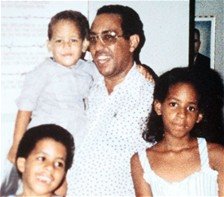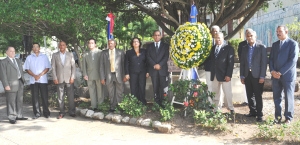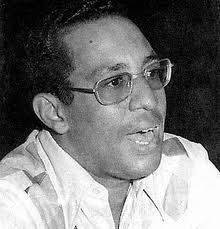Related LinksThe Final Battle: Ríos Montt's Counterinsurgency Campaign Indicted for Genocide: Guatemala's Efraín Ríos Montt OPERATION CONDOR ON TRIAL:
LEGAL PROCEEDINGS ON LATIN AMERICAN RENDITION AND ASSASSINATION PROGRAM OPEN IN BUENOS AIRES Lifting the Veil on Colombia's "Emerald Czar" STOLEN BABIES: Argentina Convicts Two Military Dictators Update: The Guatemalan Death Squad Diary and the Right to Truth Who Killed Jaime Garzón?
|
 Narciso (Narcisazo) González with his children. Washington, D.C., May 23, 2013 – The Dominican Republic failed to thoroughly investigate the May 26, 1994, forced disappearance of celebrated journalist and university professor Narciso (Narcisazo) González, according to newly declassified documents posted today by the non-governmental National Security Archive. The evidence further confirms an Inter-American Court of Human Rights ruling from February 2012 that found the government of the Dominican Republic responsible for the forced disappearance of González, and the denial of the right to due process to his family members (fair investigation and trial). González was one of the few journalists to directly speak against President Balaguer, in a context where "few persons are willing to engage in personal attacks on the president or other powerful persons for fear of possible retaliation," and was known for "naming powerful persons allegedly involved in corrupt activities," reports a June 10, 1994 U.S. Embassy cable [Document 1]. Several days after publishing an article in the magazine La Muralla, sharply criticizing the May 16, 1994 electoral process, he was detained by government security forces and forcibly disappeared. Two years later, The New York Times reported that the Balaguer government had "shelved" the case after what human rights activists dubbed "brief and perfunctory inquiries." Prosecutors agreed to reopen the case and González's family voiced their desire that Balaguer be called to testify. [1] The newly released State Department cables provide context for the disappearance of González and its aftermath, during the spring and summer of 1994, chronicling massive protests and strikes in response to the re-election of Joaquin Balaguer in May of that year, which was widely denounced for irregularities [Document 5]. U.S. Embassy officers reported growing tensions throughout the spring, which often resulted in violent unrest, and fears of further escalation, especially after González's disappearance [Document 7]. Opposition leaders suspected government involvement in González's disappearance because of his criticism of Balaguer [Document 1] [Document 7], and as massive arrests and detentions of critics of the Balaguer government took place, even U.S. officials raised concerns of a return to the days of death squads under Balaguer's previous administrations [Document 1], [Document 7].  At the 2012 annual commemoration ceremony, University Rector, Mateo Aquino Febrillet, calls for clarification of the case at UASD (Autonomous University of Santo Domingo) where Narciso González taught. Courtesy of ElJacaguero.com Among the highlights of the cables, released to the National Security Archive under the Freedom of Information Act, are several new pieces of evidence pointing to faults and failures by the Dominican Republic in its investigations into González's disappearance:
Family members of Narciso González brought his case to the Inter-American Commission on Human Rights in July 1994, filing a petition against the government of the Dominican Republic over his forced disappearance and the government's failure to investigate it. In May 2010, the case was referred to the Inter-American Court, which issued its ruling in February 2012, finding the Dominican Republic responsible and mandating various reparation measures. As of May 26, 2013, 19 years will have passed since Narciso González was disappeared. The Dominican Republic has missed deadlines for compliance with the measures of redress ordered in the judgment and has yet to report to the Inter-American Court, in contravention of its international responsibilities.
THE DOCUMENTSDocument 1: U.S. Embassy Cable, "Follow Up on PRD Detentions, Arrests of Union Officials, Disappearance of University Professor," 10 June 1994. Document 2: U.S. Embassy Cable, "Threats of Violence, Strikes at Autonomous University of Santo Domingo," 14 June 1994. Document 3: U.S. Embassy Cable, "Reports of Governing Party Intimidation of Intellectuals," 22 June 1994. Document 4: U.S. Embassy Cable, "Disappearance of University Professor Remains Unresolved," 23 June 1994. Document 5: U.S. Embassy Cable, "Current State of Play in Dominican Electoral Crisis," 11 July 1994. Document 6: U.S. Embassy Cable,"Proposed Agenda Items," 12 July 1994. Document 7: U.S. Embassy Cable, "Civil Unrest in the Dominican Republic," 13 July 1994. Document 8: U.S. Embassy Cable, "Dominican Republic: Draft Country Report on Human Rights Practices," 4 October 1994. Document 9: U.S. Embassy Cable,"Dominican Human Rights Committee: Update on Practices," 20 October 1994. Document 10: U.S. Embassy Cable,"Dominican Police Seeks Liaison Officer Assistance Re Narciso Case," 2 December 1994. Document 11: U.S. Embassy Cable,"Call on New Police Chief: Raising the Narcisazo Case," 8 December 1994. Document 12: U.S. Embassy Cable, "Balaguer Names New Customs and Police Chiefs," 16 Dec 1994. December 13: Secretary of State Cable,"Dominican Republic: Initial Edit of 1994 Country Report on Human Rights Practices," 22 Dec 1994. December 14: U.S. Embassy Cable,"Dominican Republic: Revisions for 1994 Country Report on Human Rights Practices," 5 January 1995. Document 15: State Department Letter, "[State Dept. Response to Senator Cohen Inquiry]," c. 18 January 1995. Document 16: Secretary of State Cable, "Human Rights Report on the Dominican Republic," 25 January 1995. Document 17: U.S. Embassy Cable, "Dominican Republic: Draft Country Report on Human Rights Practices," 2 October 1995. Document 18: U.S. Embassy Cable,"Ambassador Calls on Newly-Appointed Police Chief," 13 November 1995. Document 19: U.S. Embassy Cable, "Ambassador's Courtesy Call on Secretary of Interior and Police Norge Botello," 25 September 1996. Document 20: U.S. Embassy Cable, "Dominican Republic: Draft Country Report on Human Rights Practices," 2 October 1996. Document 21: U.S. Embassy Cable, "President Fernandez Fires Armed Forces Secretary," 4 November 1996. Document 22: U.S. Embassy Cable, "GODR Responds to OAS on Disappearance of Narciso Gonzalez," 22 November 1996. Document 23: U.S. Embassy Cable, "Dominican Highlights (Nov 23 - 29)," 29 November 1996. Document 24: U.S. Embassy Cable, "Dominican Highlights (Jan 4 - 10)," 10 January 1997. Document 25: U.S. Embassy Cable, "Narcisazo Case: Ambassador's Conversation with President Fernandez," 11 April 1997. Document 26: U.S. Embassy Cable, "Dominican Highlights — June 14-20," 20 June 1997. Document 27: U.S. Embassy Cable, "Dominican Highlights — August 9-15," 15 August 1997. Document 28: U.S. Embassy Cable, "Dominican Highlights — Sept 13-19," 21 September 1997. Document 29: U.S. Embassy Cable, "First Draft Submission of Dominican Republic Human Rights Report," 30 September 1997. Document 30: U.S. Embassy Cable,"Dominican Highlights — Oct 11-17, 1997," 21 Oct 1997. Document 31: U.S. Embassy Cable,"Narcisazo Case - Update," 5 November 1997. Document 32: U.S. Embassy Cable, "Little Progress in Narciso Investigation," 6 Feb 1998. Document 33: U.S. Embassy Cable,"Dominican Highlights — February 28 - March 6, 1998," 6 March 1998. Document 34: U.S. Embassy Cable, "Dominican Request for Polygraph," 15 May 1998. Document 35: U.S. Embassy Cable, "Progress in Narciso Investigation?" 9 June 1998. Document 36: U.S. Embassy Cable, "Dominican Highlights — June 13-19, 1998," 19 June 1998. Document 37: U.S. Embassy Cable, "Dominican Highlights — June 20-26, 1998," 26 June 1998. Document 38: U.S. Embassy Cable,"1998 Country Human Rights Report for the Dominican Republic," 5 October 1998. Document 39: U.S. Embassy Cable,"Dominican Highlights — Jan 11-15, 1999," 19 January 1999. Document 40: Secretary of State Cable,"Official-Informal - Draft Human Rights Report to Review," 29 January 1999. Document 41: U.S. Embassy Cable,"Post Response to Initial Edit of 1998 Country Report on Human Rights Practices," 11 February 1999. Document 42: Secretary of State Cable, "Official-Informal: HRR V-2 to Review," 21 February 1999. Document 43: U.S. Embassy Cable,"Post Response to Version 2 of the 1998 Country Report on Human Rights Practices," 23 February 1999. Document 44: U.S. Embassy Cable, "Country Human Rights Report for the Dominican Republic, 1999," 8 October 1999. Document 45: State Department Letter, "[DR - HR Case of Gonzalez]," 4 December 1999. Document 46: U.S. Embassy Cable,"Dominican Highlights: Mar. 11- Mar. 17, 2000," 17 March 2000. Document 47: U.S. Embassy Cable,"Dominican Highlights — May 19 - 26, 2000," 30 May 2000. Document 48: U.S. Embassy Cable, "Dominican Republic 2000 Human Rights Report," 10 October 2000. Document 49: U.S. Embassy Cable, "Dominican Republic 2001 Human Rights Report," 19 January 2001.
NOTES[1] The New York Times , November 24, 1996.
|
 Celebrated Journalist and University Professor, Narciso (Narcisazo) González. |
Forced Disappearance in the Dominican RepublicGovernment Impunity in Narciso González Case Continues after 19 YearsInter-American Court Ruling Confirmed by Declassified DocumentsNational Security Archive Electronic Briefing Book No. 429Posted – May 23, 2013 Edited by Emily Willard For more information contact: |

